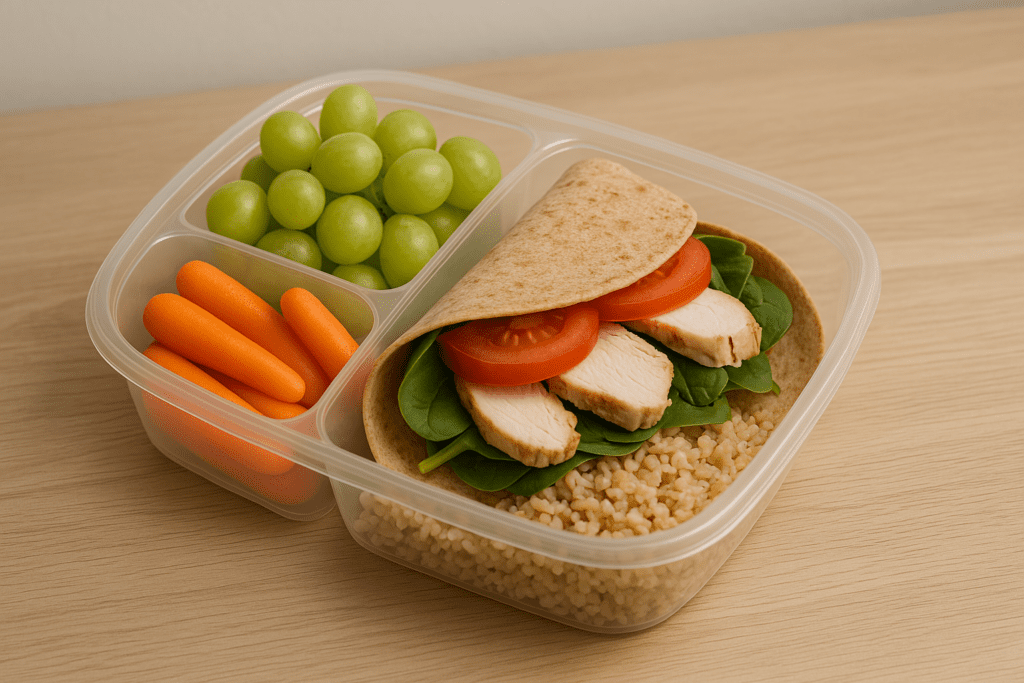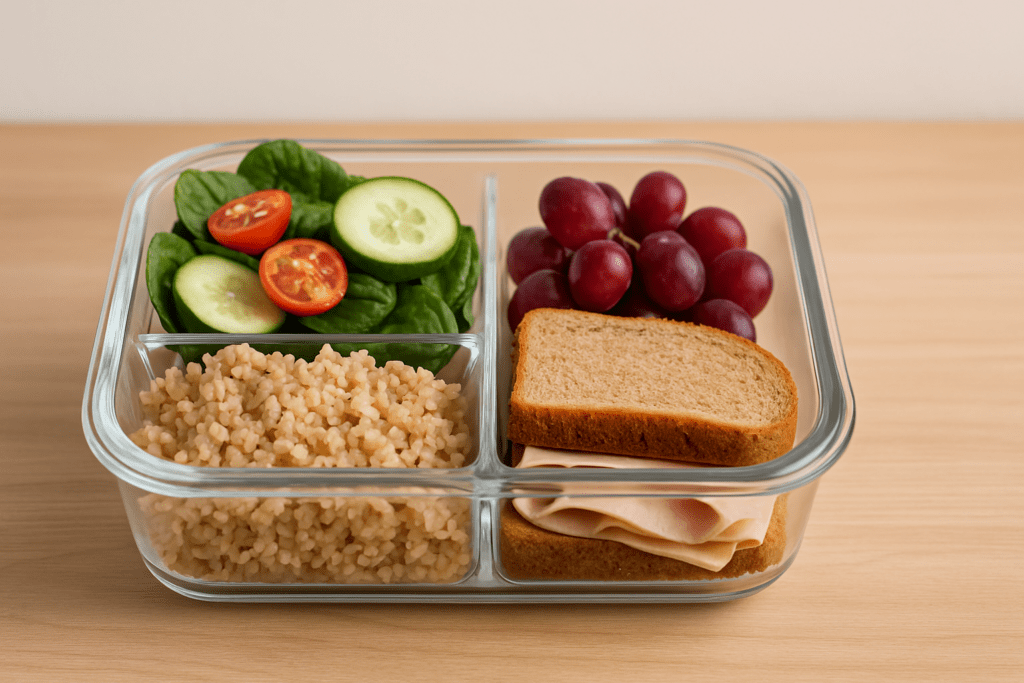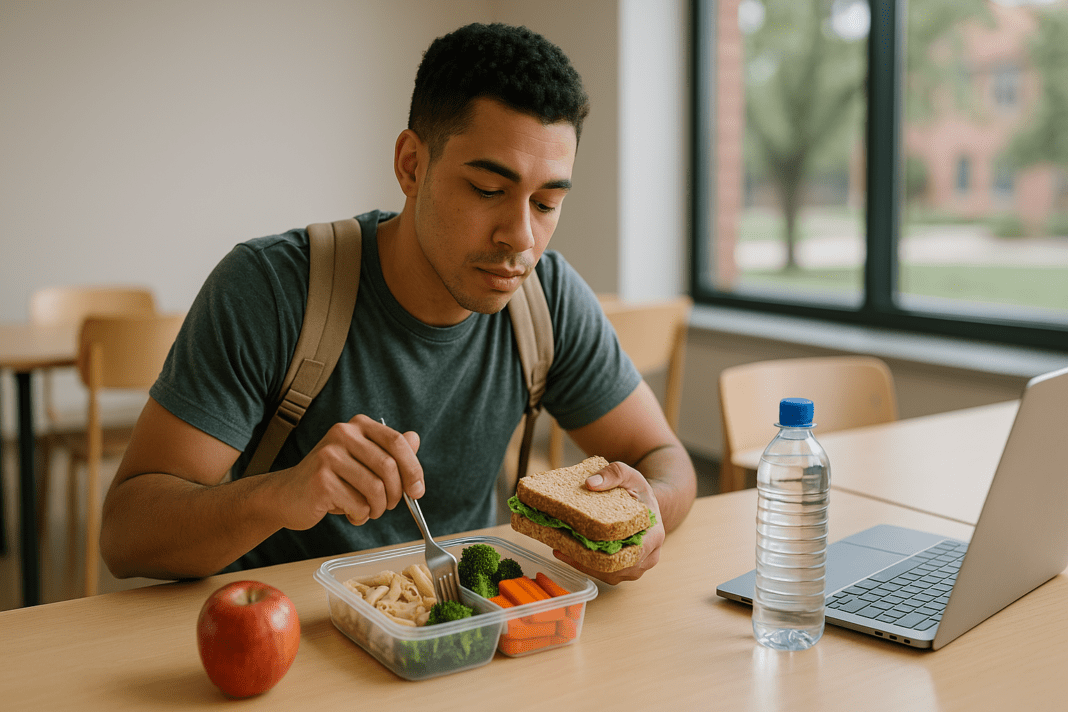College life is often a whirlwind of lectures, deadlines, study sessions, and social events. Amid this hustle, students frequently find themselves sacrificing proper nutrition in favor of convenience. However, developing smart and sustainable eating habits during these formative years is crucial not only for academic performance but also for long-term health. With a bit of planning and creativity, it is entirely possible to enjoy delicious, affordable, and nutritious meals, even on the tightest schedule. This article offers a comprehensive guide to smart and healthy college lunch ideas designed to support students who are constantly on the move.
You may also like: Smart Healthy Eating Tips for Busy Professionals: How to Stay Nourished When You’re Always on the Go
Understanding the Importance of Nutrition in College
Nutrition plays a pivotal role in cognitive function, energy levels, immune system strength, and emotional well-being. Unfortunately, many college students resort to vending machine snacks or fast food due to limited time or cooking skills. Skipping meals or relying on processed options can lead to blood sugar imbalances, decreased concentration, and even chronic fatigue. Establishing a routine of healthy eating can significantly enhance memory, focus, and resilience against stress.
One of the most overlooked aspects of healthy eating is meal timing. Students often fall into irregular eating patterns, either skipping lunch entirely or consuming it late in the day. Consistently fueling the body with balanced meals ensures a steady supply of glucose to the brain, improving alertness and academic performance. Prioritizing wholesome lunch options can act as a preventive measure against the infamous mid-afternoon energy slump that tends to derail productivity.
Balancing Macronutrients for Optimal Performance
A well-rounded college lunch should ideally include a balance of macronutrients: carbohydrates, proteins, and healthy fats. Carbohydrates provide the primary source of energy for the brain, while protein supports muscle repair and immune function. Healthy fats play a role in hormone regulation and prolonged satiety, preventing the urge to snack unnecessarily.
Smart combinations might include whole-grain wraps filled with grilled chicken and avocado, quinoa bowls topped with roasted vegetables and hummus, or lentil soups paired with whole-grain bread. These types of meals are not only nourishing but also easy to pack and reheat if needed. Including fresh fruits and vegetables adds essential vitamins, antioxidants, and fiber to the meal, promoting digestion and supporting overall health.
Incorporating lunch ideas for college students that reflect these macronutrient balances ensures meals are both satisfying and functional. Whether students have access to a communal kitchen or rely on a mini-fridge and microwave, there are countless ways to put together meals that meet nutritional needs without being overly complex.

Planning Ahead to Save Time and Reduce Stress
Effective meal planning is a game-changer for busy students. Setting aside an hour each week to prepare ingredients or batch-cook meals can dramatically reduce daily decision fatigue. Preparing grains like brown rice or farro in bulk, roasting a tray of vegetables, and portioning out proteins like tofu, chicken, or beans can streamline the lunch-making process throughout the week.
Investing in a few reusable containers makes it easier to grab and go in the morning, eliminating the temptation to purchase convenience foods on campus. Planning ahead also helps avoid food waste and saves money, two concerns that resonate strongly with the student population. Incorporating versatile ingredients that can be used in multiple dishes—such as canned beans, eggs, or mixed greens—adds flexibility to the weekly meal rotation.
Adopting these strategies supports both physical well-being and mental clarity, allowing students to focus more effectively on academic and extracurricular pursuits. Moreover, the act of meal prepping can be a grounding ritual in a lifestyle often characterized by unpredictability and high pressure.
Affordable and Accessible Ingredients for Student Budgets
Affordability is a central concern when developing college lunch ideas. Contrary to popular belief, eating healthy does not require premium ingredients or trendy superfoods. Staples such as oats, frozen vegetables, canned tuna, lentils, brown rice, and eggs are not only budget-friendly but also rich in nutrients.
Shopping with a list and sticking to a budget can prevent impulse purchases and ensure that the essentials are covered. Farmers’ markets and discount grocery stores often provide fresh produce at lower prices, and buying in bulk can lead to long-term savings. When possible, students can also take advantage of campus food pantries or co-op programs, which often provide access to nutritious foods at reduced or no cost.
The key lies in creative preparation and seasoning. Spices and herbs like garlic powder, cumin, chili flakes, and basil can transform simple ingredients into flavorful dishes. A basic chickpea salad made with lemon, olive oil, and chopped vegetables becomes a satisfying, protein-rich lunch that costs just a few dollars to prepare.
Quick and Easy Meal Ideas for Busy Days
For those days when time is particularly limited, it helps to have a few go-to meals that require minimal preparation. Overnight oats with chia seeds and fruit make for a wholesome breakfast that can double as a mid-day snack. Whole-grain sandwiches layered with nut butter and banana or hummus and shredded carrots are nutritious and portable.
Pre-made grain salads, such as couscous with cherry tomatoes and feta or a rice and bean mix with cilantro and lime, can be made in bulk and stored for several days. Soups and stews made in a slow cooker or Instant Pot also lend themselves well to batch cooking and freezing. Wraps and burritos filled with greens, beans, rice, and salsa offer a customizable and satisfying lunch that can be eaten hot or cold.
These types of college lunch ideas are ideal for students juggling internships, part-time jobs, or intensive course loads. By keeping ingredients simple and methods straightforward, students are more likely to stick with healthy habits throughout the semester.

Navigating Campus Dining Options Mindfully
While many students have access to dining halls, the array of choices can be overwhelming. It is easy to gravitate toward comfort foods or sugary snacks during periods of stress. However, practicing mindful eating within the campus dining environment can lead to healthier choices and a better understanding of personal nutritional needs.
Selecting grilled rather than fried proteins, opting for steamed vegetables, and including a serving of whole grains can elevate the quality of any cafeteria meal. Students should aim to build a plate that mirrors the USDA MyPlate model, incorporating half a plate of vegetables and fruits, a quarter plate of protein, and a quarter plate of grains.
Additionally, students can consider customizing their meals by combining elements from different stations. For instance, adding grilled chicken from the entrée section to a vegetable stir-fry from the vegetarian station creates a more balanced and satisfying lunch. Asking dining staff about ingredient sourcing and preparation methods can also help students make informed decisions.
Portable Lunch Solutions for Commuter Students
Commuter students face unique challenges when it comes to lunch planning. Without regular access to a kitchen or campus dining facilities, portable meals become essential. Investing in an insulated lunch bag and a couple of high-quality food containers can keep meals fresh for hours.
Ideal portable meals include pasta salads with chickpeas and spinach, wraps made with whole-wheat tortillas and lean protein, and mason jar salads layered to preserve texture. Fruit, hard-boiled eggs, yogurt, and trail mix also make convenient snacks that round out a lunch box. Choosing shelf-stable items like nut butter packets, canned fish, or whole-grain crackers provides additional options when refrigeration isn’t available.
Creating a system for rotating meals helps avoid repetition fatigue, which can be a major deterrent to consistent healthy eating. Building a weekly lunch schedule based on convenience, portability, and nutrition allows commuter students to maintain energy levels and avoid costly takeout meals.
Plant-Based and Vegetarian Lunch Ideas That Satisfy
For students following plant-based or vegetarian diets, lunch planning can sometimes feel limiting. However, the abundance of plant-based ingredients available today makes it easier than ever to create balanced and satisfying meals. Incorporating a variety of legumes, whole grains, nuts, seeds, and vegetables ensures that vegetarian meals are nutrient-dense and protein-rich.
Some lunch ideas for college students following a vegetarian lifestyle include lentil stew with kale, black bean tacos with avocado, and tofu stir-fry with brown rice. These meals are not only hearty and satisfying but also simple to prepare in large batches. Plant-based eaters should pay attention to iron, vitamin B12, and omega-3 intake, ensuring their meals include fortified foods or appropriate supplements.
Experimenting with global cuisines can keep meals exciting. Dishes like Mediterranean grain bowls, Indian chana masala, or Thai peanut noodles provide variety while incorporating key nutrients. For those with limited cooking time, premade plant-based items such as veggie burgers or marinated tofu can simplify the process without sacrificing health benefits.
Maximizing Nutrition with Simple Swaps
Small changes in ingredient selection can have a significant impact on overall nutrition. Swapping white bread for whole-grain varieties increases fiber intake, which promotes fullness and digestive health. Choosing Greek yogurt over flavored varieties reduces added sugar while increasing protein content.
Instead of sugary beverages, students can hydrate with infused water, herbal teas, or sparkling water. Replacing processed snacks with options like air-popped popcorn, roasted chickpeas, or fresh fruit can help reduce sodium and unhealthy fat consumption. These simple changes contribute to a long-term shift in dietary habits without requiring a complete overhaul of familiar routines.
Another smart tactic involves reading food labels and becoming aware of added sugars, sodium levels, and artificial ingredients. With time, students develop the skills to make healthier choices instinctively. Empowering oneself with nutritional knowledge leads to increased autonomy and confidence in food selection, both on and off campus.

Creating Sustainable Lunch Habits for Lifelong Health
Establishing nutritious eating habits in college lays the foundation for lifelong wellness. As students transition into adulthood, the skills they develop in meal planning, grocery budgeting, and balanced eating become invaluable. By viewing food as a form of self-care and empowerment, students are more likely to sustain these practices beyond their university years.
College lunch ideas that emphasize sustainability—such as using reusable containers, minimizing food waste, and choosing seasonal produce—also support environmental well-being. Understanding the broader impact of food choices encourages a more mindful relationship with consumption, promoting both personal health and planetary responsibility.
Integrating lunch preparation into a weekly routine fosters consistency. Whether through meal prep Sundays, collaborative cooking with roommates, or keeping a stocked pantry of essentials, building a system that works for one’s lifestyle is key. In doing so, students can experience the benefits of better nutrition without sacrificing the spontaneity and joy of their college years.
Frequently Asked Questions: Smart & Healthy College Lunch Ideas
1. How can I make college lunches more exciting without spending a lot of money? Spicing up your lunch doesn’t require a big budget. One strategy is to incorporate global flavors using inexpensive spices, sauces, and condiments. For example, adding sriracha to a rice bowl or using tahini in a wrap can dramatically enhance the taste. Another tip is to rotate ingredients creatively—try alternating your base from rice to farro to couscous while keeping your favorite protein and veggies. These variations allow you to diversify your meals and make the most out of your college lunch ideas without stretching your wallet.
2. What are some lunch ideas for college students who have no access to a microwave or fridge? For students without kitchen access, shelf-stable and room-temperature-friendly meals are key. Consider assembling a wrap with nut butter and banana or preparing grain-based salads using couscous, canned beans, and sun-dried tomatoes. These college lunch ideas rely on ingredients that won’t spoil quickly, making them ideal for busy schedules. Keeping a stash of shelf-stable snacks like rice cakes, tuna packets, or trail mix also supports balanced nutrition. It’s all about choosing items that are versatile, non-perishable, and easy to prepare on the go.
3. How can meal prepping support mental wellness and reduce academic stress? Meal prepping isn’t just a time-saver—it’s also a form of self-care. By removing the daily decision-making burden around food, students can reduce cognitive fatigue, which often exacerbates stress. Consistently nourishing the body with well-prepared lunches supports stable blood sugar, which is critical for emotional regulation. This makes thoughtfully prepared lunch ideas for college students not only about convenience but also a vital tool in supporting mental health. Over time, creating a predictable and supportive food routine can be grounding amid the chaos of campus life.
4. What are some emerging trends in college lunch ideas that promote sustainability? There’s a growing movement among students to embrace zero-waste lunches. This includes using reusable containers, beeswax wraps instead of plastic bags, and bulk ingredients to cut down on packaging. Students are also leaning into plant-forward diets to reduce their environmental footprint. Composting leftovers and sourcing from local farmers’ markets when possible also tie into this eco-conscious approach. These sustainable college lunch ideas align health with ethical food practices, allowing students to eat well and act with environmental responsibility.
5. Are there psychological benefits to preparing your own lunch as a student? Absolutely. The act of preparing one’s own meals can foster a sense of autonomy, control, and accomplishment. Cooking—even in simple forms like assembling a sandwich—engages the mind creatively and promotes mindfulness. For students living independently for the first time, mastering easy lunch ideas for college students can contribute to a stronger sense of self-efficacy. The consistency of preparing a meal also offers a moment of routine and reflection, which can help manage anxiety and improve focus. It becomes less about the food alone and more about cultivating intentional habits.
6. How can students use seasonal ingredients to enhance their college lunches? Seasonal produce tends to be fresher, more flavorful, and less expensive than out-of-season alternatives. Building lunch ideas for college students around what’s in season not only supports local agriculture but also ensures nutritional diversity. For example, roasted root vegetables are great in winter grain bowls, while fresh tomatoes and cucumbers shine in summer salads. Shopping seasonally adds an element of creativity and keeps meals exciting throughout the academic year. Plus, it’s an easy way to discover new ingredients and build a broader culinary repertoire.
7. What are some lunch strategies for students with irregular class schedules? Students juggling back-to-back classes often struggle to find consistent mealtimes. One effective tactic is to pack modular meals that can be eaten in stages—like a sandwich with sides of fruit and nuts that can be enjoyed between classes. Flexible college lunch ideas include items that hold up well over time, such as pasta salads or quinoa bowls that don’t require reheating. Students can also benefit from setting calendar reminders to eat, which encourages regular nourishment even on hectic days. Having ready-to-eat options reduces the risk of skipping meals or relying on vending machines.
8. How can students with dietary restrictions still enjoy diverse and satisfying lunches? Students managing allergies or intolerances can still explore a wide variety of flavors and textures by focusing on naturally allergen-free foods. For instance, gluten-free grains like millet or rice offer great bases, and legumes provide plant-based protein without dairy or eggs. With growing demand, many stores now carry allergen-conscious condiments and snacks that can elevate simple meals. The best lunch ideas for college students with dietary restrictions revolve around whole foods and customizable elements. This ensures students don’t feel limited while still prioritizing their health.
9. How can social dining influence a student’s lunch habits on campus? Social dynamics play a huge role in food choices. When students eat together, they’re more likely to try new dishes, adopt healthier habits, or even participate in group meal prep. Sharing college lunch ideas among peers encourages accountability and inspiration, especially when navigating limited food options. Joining student clubs centered around cooking or nutrition can further strengthen these positive habits. Ultimately, the act of dining with others transforms lunch into a shared experience that supports both physical and emotional well-being.
10. What role does hydration play in supporting healthy lunch routines for students? Hydration is often overlooked, but it significantly impacts energy levels, digestion, and concentration. A well-rounded lunch doesn’t just involve solid food; pairing it with proper fluid intake can improve nutrient absorption and satiety. Encouraging lunch ideas for college students to include naturally hydrating foods like cucumbers, oranges, or soups also contributes to overall hydration. Students should aim to carry a reusable water bottle and sip throughout the day, especially if caffeine intake is high. Integrating hydration into lunch routines creates a more holistic approach to student wellness and performance.
Final Thoughts on Smart Lunch Strategies for College Students
In the midst of a busy academic life, maintaining a nutritious and balanced diet may seem daunting. Yet with thoughtful planning, practical strategies, and a commitment to health, students can fuel their bodies and minds effectively. Exploring a variety of lunch ideas for college students that align with their tastes, budgets, and schedules enables them to make empowered decisions around food.
By investing in healthy eating now, students not only improve academic performance and daily energy but also cultivate habits that support long-term wellness. From commuter-friendly meals and plant-based options to budget-conscious ingredient choices and mindful dining hall practices, the possibilities for nourishing, delicious, and accessible college lunch ideas are expansive. With the right tools and mindset, lunch becomes more than just a meal—it becomes a powerful act of self-care and an essential pillar of a healthy college lifestyle.
healthy eating for students, quick college meals, meal prep for students, affordable student lunches, nutritious student meals, balanced college meals, easy recipes for college, budget-friendly meal planning, campus dining tips, smart food choices for students, portable lunch ideas, plant-based student meals, vegetarian college recipes, dorm room cooking, brain food for studying, healthy habits for young adults, student wellness tips, time-saving meals for students, college lifestyle nutrition, sustainable eating for students
Further Reading:
Prep Your First Year College Student for Healthy Dorm Eating
Poor Eating Is Associated With Poor Health
38 Healthy College Meals Any Student (No Matter Their Cooking Experience!) Can Master
Disclaimer
The information contained in this article is provided for general informational purposes only and is not intended to serve as medical, legal, or professional advice. While NewsHealthWatch strives to present accurate, up-to-date, and reliable content, no warranty or guarantee, expressed or implied, is made regarding the completeness, accuracy, or adequacy of the information provided. Readers are strongly advised to seek the guidance of a qualified healthcare provider or other relevant professionals before acting on any information contained in this article. NewsHealthWatch, its authors, editors, and contributors expressly disclaim any liability for any damages, losses, or consequences arising directly or indirectly from the use, interpretation, or reliance on any information presented herein. The views and opinions expressed in this article are those of the author(s) and do not necessarily reflect the official policies or positions of NewsHealthWatch.

